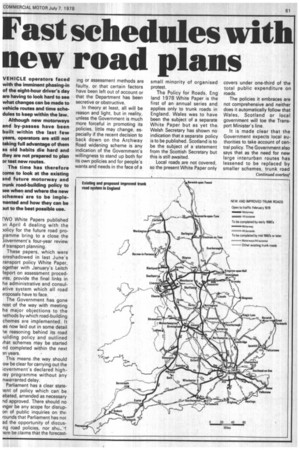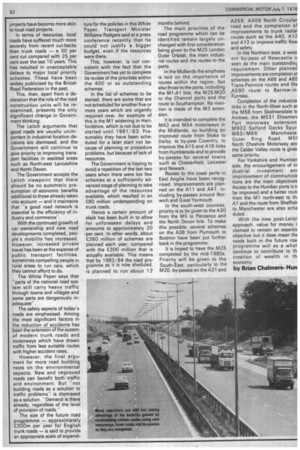Fast schedules with new road plans
Page 63

Page 64

If you've noticed an error in this article please click here to report it so we can fix it.
VEHICLE operators faced with the imminent phasing-in of the eight-hour driver's day are having to look hard to see what changes can be made to vehicle routes and time schedules to keep within the law.
Although new motorways and by-passes have been built within the last few years, operators are still not taking full advantage of them as old habits die hard and they are not prepared to plan or test new routes.
The time has therefore Come to look at the existing and future motorway and trunk road-building policy to ;ee when and where the new ;chemes are to be implemented and how they can be 3trt to the best possible use.
IWO White Papers published )n April 4 dealing with the )olicy for the future road projramme bring to a close the 3overnment's four-year review )f transport planning.
These papers, which were oreshadowed in last June's ransport policy White Paper, ogether with January's Leitch leport on assessment procedires, provide the final links in he administrative and consulative system which all road )roposals have to face.
The Government has gone nost of the way with meeting he major objections to the lethods by which road-building chemes are implemented. It 'as now laid out in some detail he reasoning behind its road ■ uilding policy and outlined /hat schemes may be started nd completed within the next an years.
This means .the way should ow be clear for carrying out the Iovernment's declared highray programme without any nwarranted delay.
Parliament has a clear statelent of policy which can be ebated, amended as necessary rid approved. There should no inger be any scope for disrupon of public inquiries on the rounds that Parliament has not ad the opportunity of discusng road policies, nor sho_'^I lere be claims that the forecast
ing or assessment methods are faulty, or that certain factors have been left out of account or that the Department has been secretive or obstructive.
In theory at least, all will be reason and light, but in reality, unless the Government is much more forceful in promoting its policies, little may change, especially if the recent decision to back down on the Archway Road widening scheme is any indication of the Government's willingness to stand up both for its own policies and for people's wants and needs in the face of a small minority of organised protest.
The Policy for Roads, Eng land 1 978 White Paper is the first of an annual series and applies only to trunk roads in England. Wales was to have been the subject of a separate White Paper but as yet the. Welsh Secretary has shown no indication that a separate policy is to be published. Scotland is to be the subject of a statement from the Scottish Secretary but this is still awaited.
Local roads are not covered, so the present White Paper only covers under one-third of the total public expenditure on roads.
The policies it embraces are not comprehensive and neither does it automatically follow that Wales, Scotland or local government will toe the Transport Minister's line.
It is made clear that the Government expects local authorities to take account of central policy. The Government also says that as the need for new large interurban routes has lessened to be replaced by smaller schemes, trunk road projects have become more akin to local road projects.
In terms of resources, local roads have suffered much more severely from recent cut-backs than trunk roads — a 50 per cent cut compared with 25 per cent over the last 10 years. This has resulted in unacceptable delays to major local priority schemes. These have been widely publicised by the British Road Federation in the past.
This, then, apart from a declaration that the role of the road construction units will be reexamined, presents the only significant change in Government thinking.
The Leitch arguments that good roads are usually unimportant in industrial location decisions are dismissed, and the Government will continue to give priority to improving transport facilities in assisted areas such as North-east Lancashire and North Devon.
The Government accepts the Leitch viewpoint that there should be no automatic presumption of economic benefits additional to those already taken into account — and it maintains that "a good road network is essential to the efficiency of industry and commerce-.
With the continued growth of car ownership and new road developments completed, people's mobility has increased. However, increased private travel has been at the expense of public transport facilities, sometimes compelling people in rural areas to run cars, which they cannot afford to do.
The White Paper says that -parts of the national road system still carry heavy traffic through towns and villages and some parts are dangerously inadequate-.
The safety aspects of today's roads are emphasised. Among the most significant .factors in the reduction of accidents has been the extension OTihe system of modern trunk roads and motorways which have drawn traffic from less suitable routes with higher accident rates.
However, the final argument for more road building rests on the environmental aspects. New and improved roads can benefit both traffic and environment. But "not building roads as a solution to traffic problems" is dismissed as a solution. -Demand is there already, regardless of the level of provision of roads."
The size of the future road programme — approximately £300m per year for English trunk roads — is said to provide an appropriate scale of expendi ture for the policies in this White Paper. Transport Minister Williams Rodgers said at a press conference recently that he could not justify a bigger budget, even if the resources were there.
This, however, is not consistent with the fact that the Government has yet to complete its review of the priorities within the 400 or so outstanding schemes.
In the list of schemes to be started, there are some that are not scheduled for another five or more years which are urgently required now. An example of this is the M1 widening in Hertfordshire, which is not due to be started until 1981/83. Presumably they have been scheduled for a later start not because of planning or procedure problems, but because of lack of resources.
The Government is hoping to avoid a repetition of the last two years when there were too few schemes at a sufficiently advanced stage of planning to take advantage of the resources available, which resulted in an £80 million underspending on trunk roads.
Hence a certain amount of slack has been built in to allow for unforeseen delays and amounts to approximately 20 per cent. In other words, about £360 million of schemes are planned each year, compared with the £300 million that is actually available. This means that by 1983/84 the road programme as it is now sheduled, is planned to run about 12 months behind.
The main priorities of the road programme which can be identified remain largely unchanged with first consideration being given to the M25 London Outer Orbital, the main industrial routes and the routes to the ports.
In the Midlands the emphasis is laid on the importance of routes within the region, but also those to the ports, including the M 1 -A 1 link, the M25-M20 to the Channel ports and the route to Southampton. No mention is made of the M3 extension.
It is intended to complete the M42 and M54 motorways in the Midlands, so building an improved route from Stoke to Derby, to by-pass Coventry. to improve the Al 5 and Al 6 links from Humberside and to provide by-passes for several towns such as Chesterfield, Leicester and Newark.
Routes to the coast ports in East Anglia have been recognised. Improvements are planned on the All and A47, including by-passes around Norwich and Great Yarmouth.
In the south-west counties, priority is to be given to the A30 from the M5 to Penzance and the North Devon link. To make this possible, several schemes on the A38 from Plymouth to Bodmin have been put further back in the programme.
It is hoped to have the M25 completed by the mid-1980s. Priority will be given to the South--East, particularly to the M20, by-passes on the A21 and
A259, A406 North Circular road and the completion of improvements to trunk radial routes such as the A40, Al2 and Al3 to improve traffic flow and safety.
In the Northern area, a west. ern by-pass of Newcastle ie seen as the main outstandinc requirement. Other planned improvements are completion ol schemes on the A66 and A6F, Trans-Pennine routes and the A590 route to Barrow-in. Furness.
Completion of the industria links in the North-West such ae the M58 from Skelmersdale tc Aintree, the M531 Ellesmere Port motorway extension M602 Salford Docks Spur M63 /M66 Mancheste Outer Ring Road, M51 North Cheshire Motorway an( the Calder Valley route is giver some priority.
For Yorkshire and Humber side, the encouragement of in dustrial investment an improvement of communica tions are the main objectives Access to the Humber ports is ti be improved and a better rout, from the M1 north-east to thl Al and the route from Sheffiell to Manchester are also sche duled.
With the new post-Leitcl approach, value for money i claimed to remain an essentiE objective but it does mean thE roads built in the future roa programme will as a whol continue to contribute to th creation of wealth in th economy
by Brian ChalmersHun
























































































































































